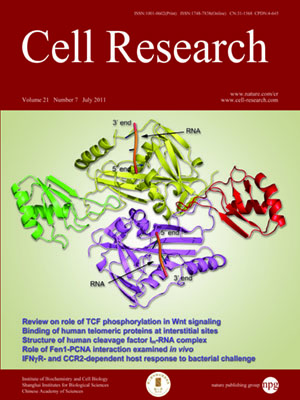
Volume 21, No 7, Jul 2011
ISSN: 1001-0602
EISSN: 1748-7838 2018
impact factor 17.848*
(Clarivate Analytics, 2019)
Volume 21 Issue 7, July 2011: 1013-1027
ORIGINAL ARTICLES
Human telomeric proteins occupy selective interstitial sites
Dong Yang2,*, Yuanyan Xiong1,*, Hyeung Kim2,*, Quanyuan He2, Yumei Li3, Rui Chen3 and Zhou Songyang1,2
1State Key laboratory for Biocontrol, Sun Yat-Sen University, Guangzhou 510275, China
2Verna and Marrs Mclean Department of Biochemistry and Molecular Biology, Baylor College of Medicine, One Baylor Plaza, Houston, TX 77030, USA
3Department of Molecular and Human Genetics, Baylor College of Medicine, One Baylor Plaza, Houston, TX 77030, USA
Correspondence: Zhou Songyang,(songyang@bcm.edu)
Human telomeres are bound and protected by protein complexes assembled around the six core telomeric proteins RAP1, TRF1, TRF2, TIN2, TPP1, and POT1. The function of these proteins on telomeres has been studied extensively. Recently, increasing evidence has suggested possible roles for these proteins outside of telomeres. However, the non-canonical (extra-telomeric) function of human telomeric proteins remains poorly understood. To this end, we systematically investigated the binding sites of telomeric proteins along human chromosomes, by performing whole-genome chromatin immunoprecipitation (ChIP) for RAP1 and TRF2. ChIP sequencing (ChIP-seq) revealed that RAP1 and TRF2 could be found on a small number of interstitial sites, including regions that are proximal to genes. Some of these binding sites contain short telomere repeats, suggesting that telomeric proteins could directly bind to interstitial sites. Interestingly, only a small fraction of the available interstitial telomere repeat-containing regions were occupied by RAP1 and TRF2. Ectopically expressed TRF2 was able to occupy additional interstitial telomere repeat sites, suggesting that protein concentration may dictate the selective targeting of telomeric proteins to interstitial sites. Reducing RAP1 and TRF2 expression by RNA interference led to altered transcription of RAP1- and TRF2-targeted genes. Our results indicate that human telomeric proteins could occupy a limited number of interstitial sites and regulate gene transcription.
Cell Research (2011) 21:1013-1027. doi:10.1038/cr.2011.39; published online 22 March 2011
FULL TEXT | PDF
Browse 2245


